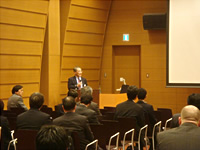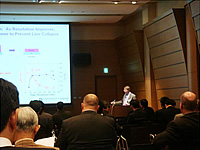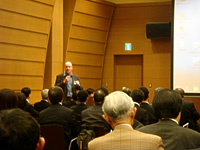


The International EUV Resist Symposium was held over two days (November 17th and 18th, 2010) at Osaka University's Nakanoshima Center concerning EUV resist research and development, an important topic within R&D conducted under the research theme "Study on Resist Materials for Nanofabrication and Development of Process Simulator" (representative researcher: Specially Appointed Professor Seiichi Tagawa, The Institute of Scientific and Industrial Research, Osaka University), which is implemented under the CREST research area "Research of Innovative Material and Process for Creation of Next-generation Electronics Devices".
EUV lithography has become the favored technology for next generation lithography, and development of each component technology is accelerating. EUV resist, in particular, has a complimentary relationship to exposure light source development and has become a key technology in the realization of EUV lithography. EUV resist has seen a great change from being founded on the knowledge base of photochemistry to that of radiation chemistry, and there still remains a great deal of room for further research and development. Currently, the JST/CREST group is leading the world in the science and technology on which EUV resist is based. This international symposium on EUV resist and related technologies was held for the purpose of bringing together the major researchers currently active in this field from around the world in order to give impetus to a global increase in sophistication and potential for realization of EUV lithography and development of EUV resist technology by deepening discussions on these topics. There were six invited speakers from overseas: Dr. Stefan Wurm (Sematech), Professor Andrew Whittaker (The University of Queensland), Professor Alex Robinson (The University of Birmingham), Associate Professor Robert Brainard (University at Albany, State University of New York), Dr. Patric Naulleau (Lawrence Berkeley National Laboratory), and Dr. Wang Yueh (Intel). Also, there were seven invited speakers from within Japan: Professor Hiroo Kinoshita (University of Hyogo), Dr. Shinji Okazaki (Extreme Ultraviolet Lithography System Development Association), Dr. Ichiro Mori (Selete), Professor Tadatomi Nishikubo (Kanagawa University), Professor Masamitsu Shirai (Osaka Prefecture University), Dr. Tatsuhiko Higashiki (Toshiba), and Dr. Toshiro Itani (Selete). So, a total of thirteen invited speakers active in the very front lines of this research field were in attendance from around the world. Along with presentations on leading edge research results from these thirteen invited speakers and five regular speakers, five individuals from the actual CREST group also introduced topics. A total of 74 people participated in the symposium.
The first day began with three keynote lectures on development of EUV lithography (by Dr. Shinji Okazaki of EUVA) and the current state and future prospects of EUV lithography (by Dr. Stefan Wurm of Sematech and Dr. Ichiro Mori of Selete), through which we were able to gain an overview understanding of EUV lithography and EUV resist. Following that, Dr. Tatsuhiko Higashiki (Toshiba) delivered a report on the current state of applications for EUV lithography devices, and Dr. Patric Naulleau (Lawrence Berkeley National Laboratory), Dr. Wang Yueh (Intel), and Professor Tadatomi Nishikubo (Kanagawa University) delivered lectures on leading edge research on EUV resist. On the second day, a special lecture by Professor Hiroo Kinoshita (University of Hyogo), the original developer of EUV lithography, gave insight into the history and significance of this type of lithography. Following that, reports on various leading edge research results concerning EUV resist from Professor Andrew Whittaker (The University of Queensland), Professor Alex Robinson (The University of Birmingham), Associate Professor Robert Brainard (University at Albany, State University of New York), Professor Masamitsu Shirai (Osaka Prefecture University), and Dr. Toshiro Itani (Selete), along with reports focusing on resist materials from regular speakers representing manufacturers of resists and materials (JSR, Tokyo Ohka Kogyo, Fuji Film, Shin-Etsu Chemical, and Mitsubishi Gas Chemical Company), provided knowledge to which the CREST research group will be able to refer to in their own work. There were questions and lively discussions throughout the program, and we were able to exchange a great deal of information within the appropriately tense atmosphere that accompanies international symposiums. Also, on the evening of the first day, many of the participants came together at a large social gathering, which proved useful for networking among those in attendance.
Five lectures were delivered by members of the actual CREST team regarding basic research on EUV resist processes (Takahiro Kozawa), sensitization processes in EUV resist (Hiroki Yamamoto), acid proliferation in EUV resist (Kazuyuki Enomoto), charge dynamics in polymers (Kazumasa Okamoto), and theoretical studies on acid generators for EUV resist (Masataka Endo). The research results presented in these lectures were highly regarded and occasioned significant discussions among many participants.
We heard from many participants that they had a high opinion of the significance of this symposium focused on EUV resist, and the meeting was successfully concluded with participants expressing high expectations for the next such meeting. Also, we were able to make this international symposium into a good opportunity to develop exchange and networking with overseas research institutions and add more positive impetus to research and development of the world's first EUV resist.
JST, an integrated organization of science and technology in Japan, establishes an infrastructure for the entire process from the creation of knowledge to the return to the society. For more information, visit http://www.jst.go.jp/EN/